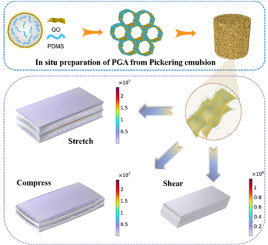Abstract
Graphene aerogel (GA) has attracted wide attention for its potential applications in various fields. However, the graphene nanosheets in the GA framework often exhibit insufficient adhesion and interfacial contact due to weak interactions, resulting in fragile cell walls and poor structural stability. Here, inspired by the principle of "soft-hard" compounding, a class of GA with extraordinary structural stability and mechanical property was prepared based on the in-situ bonding interfacial engineering between different phases in Pickering emulsion. Through interfacial engineering, the fatal compounding drawback between fusing oily polymer soft chains and water-soluble hard graphene oxide (GO) nanosheets is resolved, which enables polydimethylsiloxane (PDMS) chains to in-situ adhere onto GO nanosheets, eventually resulting in compelling structural-stable PDMS/GO aerogel (PGOA) backbone. Later, PDMS/GA (PGA) can be easily obtained by simple reduction of PGOA. The obtained PGA achieves excellent structural stability, 97.5 % elasticity, 1.7 MPa compressive capacity, and unprecedented isotropic characteristics. The assembled flexible sensor based on PGA has a high sensitivity of 17.08 kPa(-1). Additionally, PGA has low thermal conductivity (0.0245-0.0301 W/(m center dot K)) and good flame retardancy (similar to 1000 degrees C). Because of these excellent properties, PGA has a wide range of potential applications in areas such as flexible sensing, thermal protection, and fire detection.

Keywords Plus:GRAPHENE AEROGELS,NANOCOMPOSITES,POLYURETHANE,LIGHTWEIGHT,ULTRALIGHT,RESILIENT,DESIGN,SPONGE,TOUGH,OXIDE
Published in COMPOSITES PART B-ENGINEERING,Volume 288;10.1016/j.compositesb.2024.111904,JAN 1 2025


